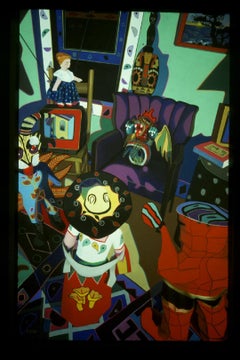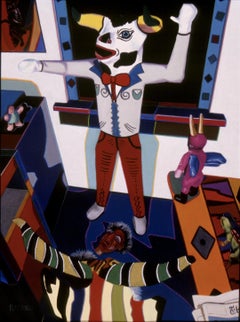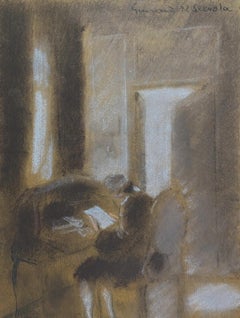Barbara Rachko Interior Drawings and Watercolors
to
1
3
Overall Width
to
Overall Height
to
4
2
2
2
3
3
3
2
2
1
1
1
1
4
4
5
28
16
15
14
4
Artist: Barbara Rachko
Practical Advice on Waiting, bright colors, domestic, Latin objects
By Barbara Rachko
Located in Brooklyn, NY
Works
Her pastel-on-sandpaper series, "Domestic Threats" and "Black Paintings", both use cultural objects as surrogates for human beings acting in mysterious, highly charged narratives.[9][10]
Rachko also has created a series of photographs entitled "Gods and Monsters".[11] In these chromogenic prints, she is "painting with a camera," creating variations that free the camera from being a mechanical recording device of what lies before it. She prints all of these images by hand.
The earlier "Domestic Threats" pastel-on-sandpaper paintings used her West Village apartment or her 1932 Sears house in Virginia as a backdrop. The "Black Paintings" series grew directly from "Domestic Threats". In the "Black Paintings," the figures (actors) take center stage. All background details, furniture, rugs, etc. have been eliminated and replaced by intense dark black pastel. Each painting takes months to complete as she slowly builds up as many as 30 layers of soft pastel.
Her long-standing fascination with traditional masks progressed in the spring of 2017 when she visited the National Museum of Ethnography and Folklore in La Paz, Bolivia where one exhibition included more than fifty festival masks. The resulting series is entitled “Bolivianos”.[12]
She has also written an e-book, From Pilot to Painter[13] and writes a regular blog, Barbara Rachko...
Category
Early 2000s Fauvist Barbara Rachko Interior Drawings and Watercolors
Materials
Pastel
Scene Twentyone: Living Room bright colors, domestic, Latin objects
By Barbara Rachko
Located in Brooklyn, NY
Price and size includes frames (maple wood with white mats).
Artwork 20" x 26"
Her pastel-on-sandpaper series, "Domestic Threats" and "Black Paintings", both use cultural objects as surrogates for human beings acting in mysterious, highly charged narratives.[9][10]
Rachko also has created a series of photographs entitled "Gods and Monsters".[11] In these chromogenic prints, she is "painting with a camera," creating variations that free the camera from being a mechanical recording device of what lies before it. She prints all of these images by hand.
The earlier "Domestic Threats" pastel-on-sandpaper paintings used her West Village apartment or her 1932 Sears house in Virginia as a backdrop. The "Black Paintings" series grew directly from "Domestic Threats". In the "Black Paintings," the figures (actors) take center stage. All background details, furniture, rugs, etc. have been eliminated and replaced by intense dark black pastel. Each painting takes months to complete as she slowly builds up as many as 30 layers of soft pastel.
Her long-standing fascination with traditional masks progressed in the spring of 2017 when she visited the National Museum of Ethnography and Folklore in La Paz, Bolivia where one exhibition included more than fifty festival masks. The resulting series is entitled “Bolivianos”.[12]
She has also written an e-book, From Pilot to Painter[13] and writes a regular blog, Barbara Rachko...
Category
Early 2000s Folk Art Barbara Rachko Interior Drawings and Watercolors
Materials
Pastel
He Was So in Need of Botany, bright colors, domestic, Latin objects
By Barbara Rachko
Located in Brooklyn, NY
Price and size includes frames (maple wood with white mats).
Artwork 58" x 38"
Her pastel-on-sandpaper series, "Domestic Threats" and "Black Paintings", both use cultural objects as surrogates for human beings acting in mysterious, highly charged narratives.[9][10]
Rachko also has created a series of photographs entitled "Gods and Monsters".[11] In these chromogenic prints, she is "painting with a camera," creating variations that free the camera from being a mechanical recording device of what lies before it. She prints all of these images by hand.
The earlier "Domestic Threats" pastel-on-sandpaper paintings used her West Village apartment or her 1932 Sears house in Virginia as a backdrop. The "Black Paintings" series grew directly from "Domestic Threats". In the "Black Paintings," the figures (actors) take center stage. All background details, furniture, rugs, etc. have been eliminated and replaced by intense dark black pastel. Each painting takes months to complete as she slowly builds up as many as 30 layers of soft pastel.
Her long-standing fascination with traditional masks progressed in the spring of 2017 when she visited the National Museum of Ethnography and Folklore in La Paz, Bolivia where one exhibition included more than fifty festival masks. The resulting series is entitled “Bolivianos”.[12]
She has also written an e-book, From Pilot to Painter[13] and writes a regular blog, Barbara Rachko...
Category
Early 2000s Fauvist Barbara Rachko Interior Drawings and Watercolors
Materials
Pastel
Scene Fourteen: Kitchen, bright colors, domestic, Latin objects
By Barbara Rachko
Located in Brooklyn, NY
Price and size includes frames (maple wood with white mats).
Artwork 58" x 38"
Her pastel-on-sandpaper series, "Domestic Threats" and "Black Paintings", both use cultural objects as surrogates for human beings acting in mysterious, highly charged narratives.[9][10]
Rachko also has created a series of photographs entitled "Gods and Monsters".[11] In these chromogenic prints, she is "painting with a camera," creating variations that free the camera from being a mechanical recording device of what lies before it. She prints all of these images by hand.
The earlier "Domestic Threats" pastel-on-sandpaper paintings used her West Village apartment or her 1932 Sears house in Virginia as a backdrop. The "Black Paintings" series grew directly from "Domestic Threats". In the "Black Paintings," the figures (actors) take center stage. All background details, furniture, rugs, etc. have been eliminated and replaced by intense dark black pastel. Each painting takes months to complete as she slowly builds up as many as 30 layers of soft pastel.
Her long-standing fascination with traditional masks progressed in the spring of 2017 when she visited the National Museum of Ethnography and Folklore in La Paz, Bolivia where one exhibition included more than fifty festival masks. The resulting series is entitled “Bolivianos”.[12]
She has also written an e-book, From Pilot to Painter[13] and writes a regular blog, Barbara Rachko...
Category
2010s Folk Art Barbara Rachko Interior Drawings and Watercolors
Materials
Pastel
Related Items
Projet de Tissus - Fauvist Flowers Watercolor & Gouache by Raoul Dufy
By Raoul Dufy
Located in Marlow, Buckinghamshire
Botanical watercolour and gouache on paper circa 1920 by French fauvist painter Raoul Dufy. The work depicts flowers in red, blue and green. This work was executed by Dufy as a fabric design.
Dimensions:
Framed: 19.5"x19.5"
Unframed: 12"x12"
Provenance:
Private collection of works by Raoul Dufy for Bianchini Ferier
Bianchini Ferrier Collection - Christie's London - July 2001
SF Fall Show
Raoul Dufy was one of a family of nine children, including five sisters and a younger brother, Jean Dufy, also destined to become a painter. Their father was an accountant in the employ of a major company in Le Havre. The Dufy family was musically gifted: his father was an organist, as was his brother Léon, and his youngest brother Gaston was an accomplished flautist who later worked as a music critic in Paris. Raoul Dufy's studies were interrupted at the age of 14, when he had to contribute to the family income. He took a job with an importer of Brazilian coffee, but still found time from 1892 to attend evening courses in drawing and composition at the local college of fine arts under Charles Marie Lhullier, former teacher of Othon Friesz and Georges Braque. He spent his free time in museums, admiring the paintings of Eugène Boudin in Le Havre and The Justice of Trajan in Rouen. A municipal scholarship enabled him to leave for Paris in 1900, where he lodged initially with Othon Friesz. He was accepted by the École des Beaux-Arts, where he studied under Léon Bonnat, whose innate conservatism prompted Dufy to remark later that it was 'good to be at the Beaux-Arts providing one knew one could leave'.
And leave he did, four years later, embarking with friends and fellow students on the rounds of the major Paris galleries - Ambroise Vollard, Durand-Ruel, Eugène Blot and Berheim-Jeune. For Dufy and his contemporaries, Impressionism represented a rejection of sterile academism in favour of the open-air canvases of Manet, the light and bright colours of the Impressionists, and, beyond them, the daringly innovative work of Gauguin and Van Gogh, Seurat, Cézanne, Toulouse-Lautrec and others. Dufy was an out-and-out individualist, however, and was not tempted to imitate any of these artists. He produced, between 1935 and 1937, Fée Electricité (Spirit of Electricity), the emblem for the French utilities company Electricité de France (EDF).
Dufy visited the USA for the first time in 1937, as a member of the Carnegie Prize jury. In 1940, the outbreak of war (and his increasingly rheumatic condition) persuaded him to settle in Nice. When he eventually returned to Paris 10 years later, his rheumatism had become so debilitating that he immediately left for Boston to follow a course of pioneering anti-cortisone treatment. He continued working, however, spending time first in Harvard and then in New York City before moving to the drier climate of Tucson, Arizona. The cortisone treatment was by and large unsuccessful, although he did recover the use of his fingers. He returned to Paris in 1951 and decided to settle in Forcalquier, where the climate was more clement. Within a short time, however, he was wheelchair-bound. He died in Forcalquier in March 1953 and was buried in Cimiez.
Between 1895 and 1898, Raoul Dufy painted watercolours of landscapes near his native Le Havre and around Honfleur and Falaise. By the turn of the century, however, he was already painting certain subjects that were to become hallmarks of his work - flag-decked Parisian cityscapes, Normandy beaches teeming with visitors, regattas and the like, including one of his better-known early works, Landing Stage at Ste-Adresse. By 1905-1906 Friesz, Braque, Matisse, Derain, Vlaminck, Van Dongen and Rouault were described collectively as Fauves (the wild beasts). What they had in common was a desire to innovate, but they felt constrained nonetheless to meet formally to set out the guiding principles of what promised to be a new 'movement'. Dufy quickly established that those principles were acceptable; moreover, he was most impressed by one particular painting by Henri Matisse ( Luxury, Calm and Voluptuousness) which, to Dufy, embodied both novelty and a sense of artistic freedom. Dufy promptly aligned himself with the Fauves. Together with Albert Marquet in particular, he spent his time travelling the Normandy coast and painting views similar...
Category
1920s Fauvist Barbara Rachko Interior Drawings and Watercolors
Materials
Paper, Watercolor, Gouache
$12,778
H 19.5 in W 19.5 in
L V Guirand de Scevola (1871-1950) A Man writing at his desk , Signed pastel
By Lucien-Victor Guirand de Scévola
Located in Paris, FR
Lucien-Victor Guirand de Scevola (1871-1950)
A Man writing at his desk, 18th century interior scene
Pastel on paper
Signed upper right
20.5 x 15.8 cm
Framed under glass : 37 x 31.5 cm
It is known that Guirand de Scevola was very interested in the Palace of Versailles and its Old Regime atmosphere, that he often painted it and that he participated in the Versailles Revival movement at the beginning of the century. This probably led him to paint scenes in the 18th century style, for which he was particularly well known and which are still sought after.
What is striking is the modernity of the execution of our pastel, which obviously contrasts with its subject in the style of the 18th century. Guirand de Scevoal is a great colourist and he proves it here with eclat, by building up his composition with white pastel highlights, contrasting with brown and black. There is something of the northern painters in this treatment of light. All this, as always with him, is very subtle. The light radiating from the window is almost an abstract notation, but it gives meaning to this interior scene.
Lucien-Victor Guirand de Scévola ( 1871 – 1950) was a French painter.
He was student of Fernand Cormon and Pierre Dupuis...
Category
1920s Art Deco Barbara Rachko Interior Drawings and Watercolors
Materials
Pastel
"Frammenti" Original Drawing Large Size- Art by Marilina Marchica
By Marilina Marchica
Located in Agrigento, AG
Title: Fragments
Artist: Marilina Marchica (1984, Agrigento – Italy)
Year: 2024
Medium: Charcoal on high-quality Fabriano paper
Size: 50 x 70 cm
Frame: Custom handmade frame availabl...
Category
2010s Contemporary Barbara Rachko Interior Drawings and Watercolors
Materials
Paper, Charcoal, Pastel
$1,342 Sale Price
20% Off
H 27.56 in W 19.69 in D 0.79 in
"Orientalist Interior" Watercolor by Philippe Jullian Ex- D.D. Ryan Estate
By Philippe Jullian
Located in Bristol, CT
Elegant & fabulously rare, original Philippe Jullian (1919-1977) (ink signed LR) watercolour depicting a lavish Moorish opium salon interior with a reclining nude portrait on the wall and two monkeys with their turban clad handler.
Sagittarius Gallery, NY label inscribed Jullian No. 18 on verso
Art Sz: 8 3/4"H x 11 1/8"W
Frame Sz: 16"H x 18"W
w/ Hermes orange mat & antique bamboo frame
Provenance: The estate of D. D. Ryan (1928-2007), noted fashion editor at Harper's Bazaar, an associate of Halston and a regular on best-dressed lists! Another widely appreciated achievement is her association with the creation of Eloise, the fictional little girl who lives at the Plaza Hotel.
Eloise began as a character that Kay Thompson, a cabaret singer, portrayed to amuse her friends, of whom Ms. Ryan was one. Ms. Ryan urged her to write a book, put her together with Hilary Knight, the illustrator, and never stopped pushing her to finish the job. The result was “Eloise,” published in 1955 and a best seller the next year, and its popular sequels.
“The book would never have existed without D. D. Never,” Mr. Knight said in an interview Thursday. “She would have just dropped it and gone on to something else.”
Beyond her historic Eloise moment, Ms. Ryan thrived at the crossroads of New York’s fashion and artistic worlds, seeming to make a statement every time she dressed, almost always in clothes she made herself, always recognizable with her famous precisely stylized eyebrows.
Her first job in Manhattan was as an assistant to the photographer Richard Avedon; she was photo editor at Harper’s Bazaar under the legendary editor Diana Vreeland, and she designed the costumes for Stephen Sondheim’s 1970 Broadway musical “Company.”
Her social circle included Cole Porter, Andy Warhol, Mr. Sondheim and Truman Capote. When she recommended a new pair of sandals or a piece of costume jewelry — only “really good costume jewelry...
Category
20th Century Other Art Style Barbara Rachko Interior Drawings and Watercolors
Materials
Watercolor
Red Cactus Flower - Oil on Panel 1910´s
Located in Stockholm, SE
A fauvist still life painting of a red cactus flower by Agda Holst (1886-1976). Oil on panel, signed Agda Holst. Probably painted somewhere around 1912-1920 when she had returned to Sweden after her studies abroad. It is painted on a Swedish panel...
Category
Early 20th Century Fauvist Barbara Rachko Interior Drawings and Watercolors
Materials
Oil, Panel
$2,517 Sale Price
25% Off
H 14.97 in W 13.19 in D 1.38 in
Still life flowers oil on canvas painting fauvist
By Jordi Curos
Located in Sitges, Barcelona
Jordi Curós Ventura (1930-2007) - Still life
Oil on canvas.
Canvas measurements 35x27 cm.
Frameless.
Jordi Curós Ventura (Olot, Girona, March 4, 1930) is a Spanish painter.
He trai...
Category
1970s Fauvist Barbara Rachko Interior Drawings and Watercolors
Materials
Canvas, Oil
$287 Sale Price
40% Off
H 13.78 in W 10.63 in
fruit still life original oil on canvas painting
By Lluis Mercader
Located in Sitges, Barcelona
Lluís Mercader (Barcelona, 1898 - 1959) was a Spanish painter. Trained in Paris and Munich, he exhibited individually at the Dalmau Galleries in Barcelona (1925) and collectively ...
Category
1950s Fauvist Barbara Rachko Interior Drawings and Watercolors
Materials
Canvas, Oil
$311 Sale Price
48% Off
H 7.49 in W 9.45 in
Antique Floral Still Life with Tulips and Irises in Gouache on Paper
Located in Soquel, CA
Antique Floral Still Life with Tulips and Irises in Gouache on Paper
Finely detailed still life by Charlotte Siemers (19th Century). Several flowers are shown in a lush bouquet. Flo...
Category
1860s Rococo Barbara Rachko Interior Drawings and Watercolors
Materials
Paper, Gouache
$960 Sale Price
20% Off
H 27 in W 22 in D 1.25 in
"Frammenti" Abstract Drawing Large Size- Original Art by Marilina Marchica
By Marilina Marchica
Located in Agrigento, AG
Frammenti
Pastel on Paper (Fabriano Elle)
100x70 cm
2023
Original Art
Marilina Marchica's research delves into the relationship between Man and Nature and the emotional implications of the relationship between human and dwelling. In this research, the landscape is the protagonist. People today rule over 75% of the land not covered by ice, which has led to modifying and shaping places, ignoring the life-giving forces of nature. The attempts of modern people...
Category
2010s Contemporary Barbara Rachko Interior Drawings and Watercolors
Materials
Pastel
$853 Sale Price
20% Off
H 39.38 in W 27.56 in D 0.79 in
Still life with apples 1961. Canvas, oil, 50x70 cm
Located in Riga, LV
Still life with apples
1961. Canvas, oil, 50x70 cm
Published at book Biruta baumane on 78 page
"Still Life with Apples" is a stylized still life pain...
Category
1960s Fauvist Barbara Rachko Interior Drawings and Watercolors
Materials
Oil, Canvas
$4,603 Sale Price
20% Off
H 19.69 in W 27.56 in D 0.79 in
1950's French Fauvist Signed Oil Red Roof Tops Pink Houses Scene
Located in Cirencester, Gloucestershire
The French Town
French School (Fauvist), mid 20th century
indistinctly signed lower front
oil painting on artists board, unframed
size: 15 x 18 inches
condition: very good
provenance: from a private collection in Paris
Superb mid 20th century French Fauvist...
Category
Mid-20th Century Fauvist Barbara Rachko Interior Drawings and Watercolors
Materials
Oil
$878 Sale Price
20% Off
H 15 in W 18 in
Mid Century French Study of a Chair and Geometric Arrangement
By Josine Vignon
Located in Cirencester, Gloucestershire
Title: Mid Century French Study
Artist: Josine Vignon (French 1922-2022)
Medium: Pencil/ charcoal on artists paper
Size: 25.5 (height) x 19.5 (width)
Stamped: Verso
Condition: ...
Category
Mid-20th Century Post-Impressionist Barbara Rachko Interior Drawings and Watercolors
Materials
Charcoal, Pencil
$181 Sale Price
20% Off
H 25.5 in W 19.5 in D 1 in
Barbara Rachko interior drawings and watercolors for sale on 1stDibs.
Find a wide variety of authentic Barbara Rachko interior drawings and watercolors available for sale on 1stDibs. You can also browse by medium to find art by Barbara Rachko in crayon, pastel and more. Much of the original work by this artist or collective was created during the 21st century and contemporary and is mostly associated with the Post-Impressionist style. Not every interior allows for large Barbara Rachko interior drawings and watercolors, so small editions measuring 35 inches across are available. Customers who are interested in this artist might also find the work of Victor Di Gesu, and Stephen Basso. Barbara Rachko interior drawings and watercolors prices can differ depending upon medium, time period and other attributes. On 1stDibs, the price for these items starts at $8,000 and tops out at $25,000, while the average work can sell for $16,500.





